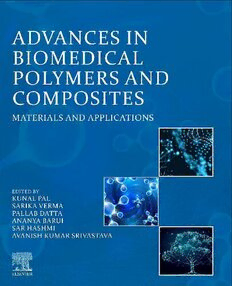
Advances in Biomedical Polymers and Composites: Materials and Applications PDF
Preview Advances in Biomedical Polymers and Composites: Materials and Applications
Advances in Biomedical Polymers and Composites Materials and Applications Advances in Biomedical Polymers and Composites Materials and Applications Edited by Kunal Pal Department of Biotechnology and Medical Engineering, National Institute of Technology Rourkela, Odisha, India Sarika Verma Materials for Radiation Shielding and Cement Free Concrete Division, CSIR-Advanced Materials and Processes Research Institute (AMPRI), Bhopal, India Pallab Datta Department of Pharmaceutics, National Institute of Pharmaceutical Education and Research, Kolkata, West Bengal, India Ananya Barui Centre for Healthcare Science and Technology, Indian Institute of Engineering Science and Technology, Shibpur, Howrah, India S. A. R. Hashmi Integrated Approach for Design and Product Development Devision, CSIR-Advanced Materials and Processes Research Institute (AMPRI), Bhopal, India Avanish Kumar Srivastava CSIR-Advanced Materials and Processes Research Institute, Bhopal, India Elsevier Radarweg29,POBox211,1000AEAmsterdam,Netherlands TheBoulevard,LangfordLane,Kidlington,OxfordOX51GB,UnitedKingdom 50HampshireStreet,5thFloor,Cambridge,MA02139,UnitedStates Copyright©2023ElsevierInc.Allrightsreserved. Nopartofthispublicationmaybereproducedortransmittedinanyformorbyanymeans,electronic ormechanical,includingphotocopying,recording,oranyinformationstorageandretrievalsystem, withoutpermissioninwritingfromthepublisher.Detailsonhowtoseekpermission,further informationaboutthePublisher’spermissionspoliciesandourarrangementswithorganizationssuch astheCopyrightClearanceCenterandtheCopyrightLicensingAgency,canbefoundatourwebsite: www.elsevier.com/permissions. Thisbookandtheindividualcontributionscontainedinitareprotectedundercopyrightbythe Publisher(otherthanasmaybenotedherein). Notices Knowledgeandbestpracticeinthisfieldareconstantlychanging.Asnewresearchandexperience broadenourunderstanding,changesinresearchmethods,professionalpractices,ormedical treatmentmaybecomenecessary. Practitionersandresearchersmustalwaysrelyontheirownexperienceandknowledgeinevaluating andusinganyinformation,methods,compounds,orexperimentsdescribedherein.Inusingsuch informationormethodstheyshouldbemindfuloftheirownsafetyandthesafetyofothers,including partiesforwhomtheyhaveaprofessionalresponsibility. Tothefullestextentofthelaw,neitherthePublishernortheauthors,contributors,oreditors,assume anyliabilityforanyinjuryand/ordamagetopersonsorpropertyasamatterofproductsliability, negligenceorotherwise,orfromanyuseoroperationofanymethods,products,instructions,orideas containedinthematerialherein. ISBN:978-0-323-88524-9 ForInformationonallElsevierpublications visitourwebsiteathttps://www.elsevier.com/books-and-journals Publisher:MatthewDeans AcquisitionsEditor:EdwardPayne EditorialProjectManager:SaraGreco ProductionProjectManager:SuryaNarayananJayachandran CoverDesigner:ChristianJ.Bilbow TypesetbyMPSLimited,Chennai,India Contents List ofcontributors.................................................................................................xxi CHAPTER 1 Introduction to biomedical polymer and composites....................................................................1 SohamChowdhury, Adhish Singh and Bidyut Pal 1.1 Introduction....................................................................................1 1.2 Classification ofpolymersand composites...................................2 1.3 Fabrication techniques polymer composites..................................3 1.3.1 Electrospinning...................................................................4 1.3.2 Meltextrusion.....................................................................4 1.3.3 Solution mixing...................................................................4 1.3.4 Latex technology.................................................................6 1.4 Polymersand their composites for biomedical applications.........7 1.4.1 Natural polymers andtheir composites..............................7 1.4.2 Synthetic polymers and their composites.........................13 1.4.3 Gas-permeablepolymeric membranes.............................18 1.4.4 Other polymeric composites.............................................19 1.5 Challenges andfuture trends........................................................22 1.6 Conclusion....................................................................................23 References....................................................................................24 CHAPTER 2 Foundation of composites...........................................31 Umesh KumarDwivedi and Neelam Kumari 2.1 Introduction..................................................................................31 2.2 Classification ofcomposites........................................................32 2.3 History ofcomposites..................................................................33 2.3.1 Fiberglass in20th century.................................................34 2.3.2 Composite materialinour daily life................................35 2.4 Why composites?.........................................................................35 2.5 Advantages of composites...........................................................35 2.5.1 Designflexibility............................................................35 2.5.2 Light weight....................................................................36 2.5.3 Highstrength...................................................................36 2.5.4 Strength relatedtoweight...............................................36 2.5.5 Corrosionresistance........................................................36 2.5.6 High-impact strength......................................................36 2.5.7 Consolidation ofmany parts...........................................37 2.5.8 Dimensional stability......................................................37 v vi Contents 2.5.9 Nonconductive................................................................37 2.5.10 Nonmagnetic...................................................................37 2.5.11 Radar transparent............................................................37 2.5.12 Low thermal conductivity...............................................38 2.5.13 Durable............................................................................38 2.6 Applications of composites..........................................................38 2.6.1 Aerospace/aircrafts............................................................38 2.6.2 Appliances.........................................................................38 2.6.3 Automobile and transportation.........................................38 2.6.4 Infrastructure.....................................................................38 2.6.5 Environmental...................................................................39 2.6.6 Applications ofelectricity.................................................39 2.7 Limitation of composites.............................................................39 2.8 Biocomposites and classification.................................................40 2.8.1 Biomedical composites.....................................................40 2.8.2 Basic requirements and parametersfor biomedical applications.......................................................................40 2.8.3 Biomedical polymer composites.......................................42 2.9 Applications of biocomposites.....................................................43 2.9.1 Tissue engineering............................................................45 2.9.2 Orthopedic.........................................................................46 2.9.3 Dental................................................................................47 2.9.4 External prosthetic andorthotics......................................49 2.9.5 Biocompatibilityon skin...................................................51 2.9.6 Healing offracture and wounddressing..........................51 2.10 Fabricationtechniques of biomedicalcomposites.......................54 2.10.1 Hand layup molding........................................................54 2.10.2 Open contact moldingmethod........................................54 2.10.3 Liquid moldingand injection molding...........................55 2.10.4 Vacuum resin transfer moldingprocess.........................55 2.10.5 Compressionmolding.....................................................56 2.10.6 Tube rolling.....................................................................57 2.10.7 Automatedfiber/tape placement process........................57 2.11 Conclusion....................................................................................58 References....................................................................................58 CHAPTER 3 Biopolymer-based composites for drug delivery applications—a scientometric analysis....................61 Kunal Pal,Deepti Bharti, PreetamSarkar and DomanKim 3.1 Introduction..................................................................................61 Contents vii 3.2 Scientometric analysis..................................................................62 3.2.1 Coauthorship analysis.......................................................64 3.2.2 Cooccurrenceanalysis......................................................66 3.2.3 Analysis of the citationsof the articles............................75 3.3 Conclusion....................................................................................80 References....................................................................................80 CHAPTER 4 Characteristics and characterization techniques of bacterial cellulose for biomedical applications—a short treatise...................................83 Kumar Anupam,Richa Aggrawal, JitenderDhiman, Priti Shivhare Lal, Thallada Bhaskarand Dharm Dutt 4.1 Introduction..................................................................................83 4.2 Biomedical applicationsof bacterial cellulose............................84 4.2.1 Wound healingapplications...........................................86 4.2.2 Diagnosis of ovarian cancer...........................................93 4.2.3 Shape memory material..................................................93 4.2.4 Preventing deterioration ofsalmon muscle and slowing down the lipid oxidation...................................94 4.2.5 Lipase immobilization....................................................94 4.2.6 Tissue engineering..........................................................94 4.2.7 Implantable devices in regenerativemedicine...............98 4.2.8 Drugdelivery..................................................................99 4.2.9 Bonehealing.................................................................100 4.2.10 Wound dressing.............................................................100 4.3 Conclusion..................................................................................105 References..................................................................................106 CHAPTER 5 Engineering scaffolds for tissue engineering and regenerative medicine..............................................109 Ibrahim Fatih Cengiz, Rui L. Reis and JoaquimMiguelOliveira 5.1 Introduction................................................................................109 5.2 Scaffoldsproperties and characterization..................................110 5.3 Fabrication ofscaffolds..............................................................114 5.3.1 Scaffold fabrication methods..........................................114 5.3.2 Patient-specific scaffolds................................................117 5.4 Conclusion..................................................................................120 Acknowledgments.....................................................................120 Declaration of conflict of interest.............................................121 References..................................................................................121 viii Contents CHAPTER 6 Recent trends in polymeric composites and blends for three-dimensional printing and bioprinting.......131 SriyaYeleswarapu, K.N. Vijayasankar, ShibuChameettachal and Falguni Pati 6.1 Introduction................................................................................131 6.2 Need of synergisticapproach in polymeric materials...............132 6.3 Blends andcomposites of natural andsynthetic polymers.......133 6.3.1 Synthetic polymers(cid:1)based composites..........................134 6.3.2 Natural polymers(cid:1)based composites.............................135 6.4 3D printing techniques employed toprint polymeric materials.....................................................................................138 6.4.1 Extrusion-based 3D printing...........................................139 6.4.2 Vatpolymerization..........................................................140 6.4.3 Powder bedfusion...........................................................141 6.4.4 Laser-assisted bioprinting...............................................143 6.5 Application of value-addedpolymers........................................143 6.6 Currentchallenges and possiblesolutions.................................145 6.7 Conclusion..................................................................................147 References..................................................................................147 CHAPTER 7 Polymers for additive manufacturing and 4D-printing for tissue regenerative applications....159 BhuvaneshwaranSubramanian,PratikDas, ShreyaBiswas, Arpita Roy and Piyali Basak 7.1 Introduction................................................................................159 7.2 Polymers for 4D printing...........................................................161 7.2.1 Hydrogels........................................................................162 7.2.2 Shape memory polymers................................................163 7.2.3 Elastomer actuators.........................................................164 7.2.4 Thermoresponsive polymers...........................................165 7.3 Application of 4D printing technology......................................166 7.3.1 Engineered tissue constructs...........................................166 7.3.2 Medical devices..............................................................169 7.3.3 Drug delivery implants...................................................170 7.4 Conclusion..................................................................................178 Reference...................................................................................178 CHAPTER 8 Bioprinting of hydrogels for tissue engineering and drug screening applications.............................183 EceO¨zmen, O¨zu¨mYıldırım and Ahu Arslan-Yıldız 8.1 Advancements inbioprinting technology..................................183 Contents ix 8.2 Bioinks........................................................................................186 8.3 Hydrogel bioinks........................................................................188 8.4 Applications ofhydrogelbioinks...............................................193 8.4.1 Bonetissue engineering..................................................198 8.4.2 Cartilage tissue engineering............................................198 8.4.3 Cardiac tissue engineering..............................................203 8.4.4 Skintissue engineering...................................................203 8.4.5 Vascular tissue engineering............................................204 8.4.6 Neural tissue engineering................................................205 8.4.7 Drugscreening................................................................206 8.5 Challenges ofbioprinted hydrogels intissue engineering and drugscreening.....................................................................209 8.6 Conclusion and future perspectives...........................................210 References..................................................................................211 CHAPTER 9 Smart polymers for biomedical applications...........223 Deepti Bharti, IndranilBanerjee, Preetam Sarkar, Doman Kim and Kunal Pal 9.1 Introduction................................................................................223 9.2 Temperature-sensitive smart polymers......................................225 9.3 Applications oftemperature-sensitive smart polymers.............226 9.4 pH-sensitive smart polymers......................................................228 9.4.1 Applications....................................................................230 9.5 Photosensitive polymers.............................................................232 9.5.1 Applications....................................................................234 9.6 Enzyme-responsive polymers....................................................237 9.6.1 Applications....................................................................238 9.7 Conclusion..................................................................................240 References..................................................................................241 CHAPTER 10 Chitosan-based nanoparticles for ocular drug delivery......................................................................247 Kunal Pal, Bikash K.Pradhan, DomanKim and Maciej Jarze˛bski 10.1 Introduction................................................................................247 10.2 Anatomy and protection mechanism ofeye..............................248 10.3 Properties ofchitosan.................................................................250 10.4 Some recentapplicationsof chitosan nanoparticles in ocular delivery............................................................................254 10.5 Conclusion..................................................................................257 References..................................................................................258 x Contents CHAPTER 11 Appraisal of conducting polymers for potential bioelectronics...........................................................265 RimitaDey and Pallab Datta 11.1 Introduction................................................................................265 11.2 Sensorsand actuators used onconducting polymers................267 11.3 Energy storage from conducting polymer.................................272 11.4 Energy harvestingbased on polymer.........................................279 11.5 Organiclight-emitting diodes....................................................283 11.6 Electrochromicmaterials and devices.......................................285 11.7 Conclusions................................................................................289 References..................................................................................289 CHAPTER 12 Shape-memory polymers..........................................299 Deepshikha Rathore 12.1 Introduction................................................................................299 12.2 Variousshape-memorypolymers..............................................300 12.2.1 Cross-linking.................................................................300 12.2.2 Thermal transitions.......................................................301 12.2.3 Categorization of shape-memory polymers..................302 12.3 Mechanism of shape-memory polymers....................................302 12.4 Composites using shape-memory polymers..............................303 12.4.1 Functionalizationofshape-memory polymers by silicate...........................................................................304 12.4.2 Functionalizationofshape-memory polymers by magnetic particles....................................................304 12.4.3 Functionalizationofshape-memory polymers by carbon fillers.................................................................306 12.4.4 Functionalizationofshape-memory polymers by biocompatible materials...........................................307 12.5 Limitations ofshape-memorypolymers....................................308 12.5.1 Recoverytime and activation process..........................308 12.5.2 Recoveryforceand work capacity...............................310 12.6 Conclusion..................................................................................312 References..................................................................................312 CHAPTER 13 Rapid prototyping......................................................315 UmeshK.Dwivedi,ShashankMishraandVishalParashar 13.1 Introduction................................................................................315 13.2 Preprocessing,the process, andpostprocessing inrapid prototyping.................................................................................319 13.2.1 Preprocessing................................................................319
